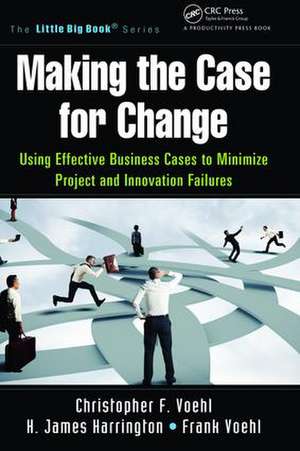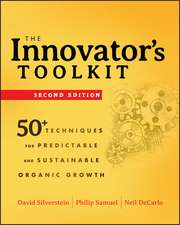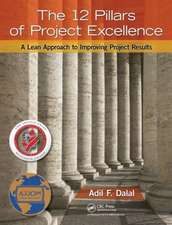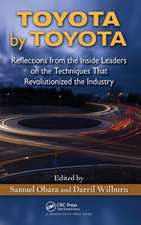Making the Case for Change: Using Effective Business Cases to Minimize Project and Innovation Failures: The Little Big Book Series
Autor Christopher F. Voehl, H. James Harrington, Frank Voehlen Limba Engleză Hardback – 15 aug 2017
| Toate formatele și edițiile | Preț | Express |
|---|---|---|
| Paperback (1) | 189.46 lei 6-8 săpt. | |
| Taylor & Francis – 3 sep 2014 | 189.46 lei 6-8 săpt. | |
| Hardback (1) | 986.91 lei 6-8 săpt. | |
| Taylor & Francis – 15 aug 2017 | 986.91 lei 6-8 săpt. |
Preț: 986.91 lei
Preț vechi: 1366.55 lei
-28% Nou
Puncte Express: 1480
Preț estimativ în valută:
188.86€ • 198.58$ • 156.04£
188.86€ • 198.58$ • 156.04£
Carte tipărită la comandă
Livrare economică 16-30 aprilie
Preluare comenzi: 021 569.72.76
Specificații
ISBN-13: 9781138463981
ISBN-10: 1138463981
Pagini: 265
Dimensiuni: 156 x 234 mm
Greutate: 0.45 kg
Ediția:1
Editura: Taylor & Francis
Colecția Productivity Press
Seria The Little Big Book Series
Locul publicării:Oxford, United Kingdom
ISBN-10: 1138463981
Pagini: 265
Dimensiuni: 156 x 234 mm
Greutate: 0.45 kg
Ediția:1
Editura: Taylor & Francis
Colecția Productivity Press
Seria The Little Big Book Series
Locul publicării:Oxford, United Kingdom
Public țintă
Professional Practice & DevelopmentNotă biografică
H. James Harrington, Christopher F. Voehl, Frank Voehl
Cuprins
Getting Started with the Business Case—Activity 1: Set the Proposal Context and Stimulus. Activity 2: Define the Sponsor’s Role and Test Alignment to Organizational Objectives. Activity 3: Prepare the BCD Team’s Charter and Output. Activity 4: Patents and Other Intellectual Property Considerations. Activity 5: Collecting Relevant Information/Data. Activity 6: Projected Improvement Analysis. Activity 7: Developing Proposed Project Recommendations, Estimates of Resources, and Return on Investment (ROI). Activity 8: Presenting the Business Case to the Executive Committee.
Descriere
Teach Your Students How to Use Computing to Explore Powerful and Creative IdeasIn the twenty-first century, computers have become indispensable in music making, distribution, performance, and consumption. Making Music with Computers: Creative Programming in Python introduces important concepts and skills necessary to generate music with computers. It interweaves computing pedagogy with musical concepts and creative activities, showing students how to integrate the creativity and design of the arts with the mathematical rigor and formality of computer science.The book provides an introduction to creative software development in the Python programming language. It uses innovative music-creation activities to illustrate introductory computer programming concepts, including data types, algorithms, operators, iteration, lists, functions, and classes. The authors also cover GUIs, event-driven programming, big data, sonification, MIDI programming, client‘server programming, recursion, fractals, and complex system dynamics.Requiring minimal musical or programming experience, the text is designed for courses in introductory computer science and computing in the arts. It helps students learn computer programming in a creative context and understand how to build computer music applications. Also suitable for self-study, the book shows musicians and digital music enthusiasts how to write music software and create algorithmic music compositions.Web ResourceA supplementary website (http://jythonMusic.org) provides a music library and other software resources used in the text. The music library is an extension of the jMusic library and incorporates other cross-platform programming tools. The website also offers example course and associated media resources.





















